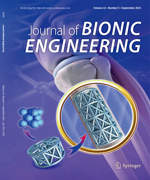The pitching-down flapping is a new type of bionic flapping, which was invented by the author based on previous studies on the aerodynamic mechanisms of fruit fly (pitching-up) flapping. The motivation of this invention is to improve the aerodynamic characteristics of flapping Micro Air Vehicles (MAVs). In this paper the pitching-down flapping is briefly introduced. The major works include: (1) Computing the power requirements of pitching-down flapping in three modes (advanced, symmetrical, delayed), which were compared with those of pitching-up flapping; (2) Investigating the effects of translational acceleration time, Δτt and rotational time, Δτr , at the end of a stroke, and the angle of attack, α, in the middle of a stroke on the aerodynamic characteristics in symmetrical mode; (3) Investigating the effect of camber on pitching-down flapping. From the above works, conclusions can be drawn that: (1) Compared with the pitching-up flapping, the pitching-down flapping can greatly reduce the time-averaged power requirements; (2) The increase in Δτt and the decrease in Δτr can increase both the lift and drag coefficients, but the time-averaged ratio of lift to drag changes a little. And α has significant effect on the aerodynamic characteristics of the pitching-down flapping; (3) The positive camber can effectively increase the lift coefficient and the ratio of lift to drag.

 Table of Content
Table of Content
 Table of Content
Table of Content